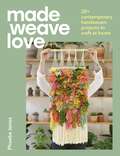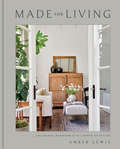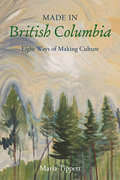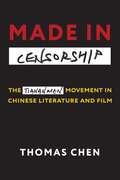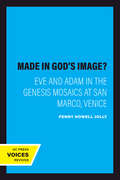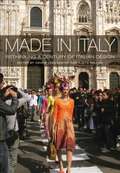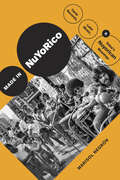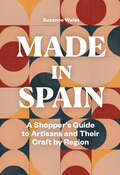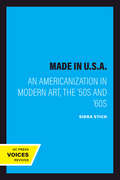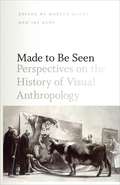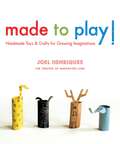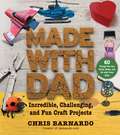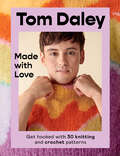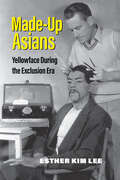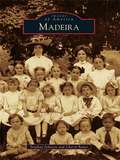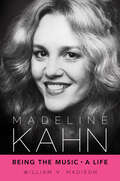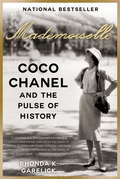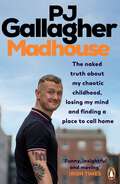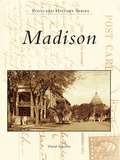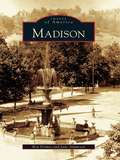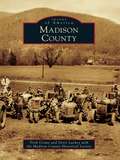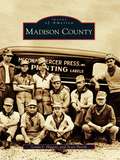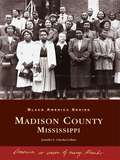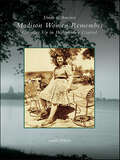- Table View
- List View
Made Weave Love: 20+ contemporary handwoven projects to craft at home
by Phoebe JonesMaster the art of weaving with over 20 stunning projects Phoebe Jones is on a mission to make weaving accessible to all. In her debut book Made Weave Love Phoebe shows you the joys of weaving and how this gentle and intuitive craft can spark creativity in your life. Covering the very basics from the essential tools and how to build your own loom, to selecting the perfect yarn and finding colour and design inspiration, Phoebe carefully guides you through everything you need to get started.Packed with beautiful photography and step-by-step tutorials throughout, this go-to guide - featuring projects for both beginners and advanced crafters alike - will give you the skills you need to confidently weave gorgeous masterpieces that spread style and colour throughout your home.
Made for Living: Collected Interiors for All Sorts of Styles
by Amber Lewis Cat ChenThe trendsetting designer known for her effortless style shares the secrets of the art of layering, with more than 250 gorgeous photographs of her signature interiors. &“Livability is my true north. The materials I use time and again all change with age and wear. Not only is that okay, it&’s how you achieve more than a re-creation of what you&’ve already seen, or what somebody else has done. You can do this, too—I promise.&”—from the introduction Designing a room with all the vibes comes down to how you layer your décor. The more you can mix the elements of your room—your pillows, objects, patterns, and lighting—the more finished it&’ll feel: not too new, not too old, but just right. Known for her eclectic approach that stems from her California cool, Amber Lewis trains your eye in Made for Living, offering friendly advice on everything from nailing that perfect shade of paint to mismatching patterns with wild abandon to choosing a stone finish for new countertops. These pages will help you design a home that's made to be lived in.
Made in British Columbia
by Maria TippettIs there such a thing as British Columbia culture, and if so, is there anything special about it? This is the broad question Dr. Maria Tippett answers in this work with an assured "yes!" To prove her point she looks at the careers of eight ground-breaking cultural producers in the fields of painting, aboriginal art, architecture, writing, theatre and music. The eight creative figures profiled in Made in British Columbia are not just distinguished artists who made an enduring mark on Canadian culture during the twentieth century. They are unique artists whose work is intimately interwoven with British Columbia's identity. Emily Carr portrayed BC's coastal landscape in a manner as unique as her lifestyle. Bill Reid's carvings, jewellery and sculpture stand as a contemporary interpretation of his reclaimed Haida heritage. The name Francis Rattenbury is less known than The Empress Hotel in Victoria, one of many prominent BC buildings he designed, while Arthur Erickson's modern architectural contributions are recognized worldwide. Martin Allerdale Grainger's experience in the BC woods in the early days of hand-logging inspired him to write one of the undisputed classics of BC fiction, Woodsmen of the West. Jean Coulthard struggled for respect as a female composer during the 1920s and 1930s in British Columbia but eventually proved her extraordinary musical talents internationally. George Woodcock left Britain in 1949 to forge his career as an influential author, editor, mentor and tireless promoter of literary scholarship in the province, while playwright George Ryga, the son of Ukrainian immigrants, exposed the anguish and reality of life for Native women in our cities with his 1967 play, The Ecstasy of Rita Joe. Featuring images of the artists and their works, Made in British Columbia presents a history of the treasures found in our galleries, concert halls, theatres, museums, libraries and streetscapes, and explores the legacy of a cultural tradition as unique as the place that nurtured it.
Made in Censorship: The Tiananmen Movement in Chinese Literature and Film
by Thomas ChenThe violent suppression of the 1989 Tiananmen Square demonstrations is thought to be contemporary China’s most taboo subject. Yet despite sweeping censorship, Chinese culture continues to engage with the history, meaning, and memory of the Tiananmen movement. Made in Censorship examines the surprisingly rich corpus of Tiananmen literature and film produced in mainland China since 1989, both officially sanctioned and unauthorized, contending that censorship does not simply forbid—it also shapes what is created.Thomas Chen explores a wide range of works made despite and through censorship, including state propaganda, underground films, and controversial best-sellers. Moving across media, from print to the internet, TV to DVD, fiction to documentary, he shows the effects of state intervention on artistic production and consumption. Chen considers art at the edge of censorship, reading such disparate works as a queer love story shot without permission that found official release on DVD, an officially sanctioned film that was ultimately not permitted to be released, a novel built on orthographic elisions that was banned and eventually reissued, and an internet narrative set during the SARS epidemic later published with alterations. He also connects Tiananmen with the story of COVID-19 in China and considers the implications for debates about the reach and power of the Chinese state in the public realm, both domestic and abroad. A bold rethinking of contemporary Chinese literature and film, this book upends understandings of censorship, uncovering not just what it suppresses but also what it produces.
Made in God's Image?: Eve and Adam in the Genesis Mosaics at San Marco, Venice (The Discovery Series #4)
by Penny Howell JollyThis title is part of UC Press's Voices Revived program, which commemorates University of California Press’s mission to seek out and cultivate the brightest minds and give them voice, reach, and impact. Drawing on a backlist dating to 1893, Voices Revived makes high-quality, peer-reviewed scholarship accessible once again using print-on-demand technology. This title was originally published in 1997.This title is part of UC Press's Voices Revived program, which commemorates University of California Press’s mission to seek out and cultivate the brightest minds and give them voice, reach, and impact. Drawing on a backlist dating to 1893, Voices Revived</DIV
Made in Italy: Rethinking a Century of Italian Design
by Kjetil Fallan Grace Lees-MaffeiGoods made or designed in Italy enjoy a profile which far outstrips the country's modest manufacturing output. Italy's glorious design heritage and reputation for style and innovation has 'added value' to products made in Italy. Since 1945, Italian design has commanded an increasing amount of attention from design journalists, critics and consumers. But is Italian design a victim of its own celebrity? Made in Italy brings together leading design historians to explore this question, discussing both the history and significance of design from Italy and its international influence. Addressing a wide range of Italian design fields, including car design, graphic design, industrial and interior design and ceramics, well-known designers such as Alberto Rosselli and Ettore Sottsass, Jr. and iconic brands such as Olivetti, Vespa and Alessi, the book explores the historical, cultural and social influences that shaped Italian design, and how these iconic designs have contributed to the modern canon of Italian-inspired goods.
Made in NuYoRico: Fania Records, Latin Music, and Salsa’s Nuyorican Meanings (Refiguring American Music)
by Marisol NegrónIn Made in NuYoRico, Marisol Negrón tells the cultural history of salsa, tracing the music’s Nuyorican meanings over a fifty-year period that begins with the establishment of Fania Records in 1964 and how it capitalized on salsa’s Nuyorican imaginary to cultivate a global audience. Drawing on interviews with fans, legendary musicians, and music industry figures as well as analyses of songs, albums, films, and archival documents, Negrón shows how Nuyorican cultural and social histories became embedded in and impacted salsa music's flows during its foundational period in the mid-1960s and its boom in the 1970s. Salsa’s Nuyorican aesthetics challenged mainstream notions of Americanness and Puerto Ricanness and produced an alternative public sphere through which New York’s poor and working-class Puerto Ricans could contest racialization and colonial power. By outlining salsa’s complicated musical, cultural, commercial, racial, gendered, legal, and political entanglements, Negrón demonstrates its centrality to Nuyorican identity and subjectivity.
Made in Spain: A Shopper's Guide to Artisans and Their Crafts by Region
by Suzanne WalesA distinctive, sumptuous, and informative guide to the craftspeople and artisans of Spain, with a focus on ceramics, jewelry, leather goods, clothing, textiles, and shoes.A celebration of artisanal craft, Made in Spain pulls back the veil on independent craftspeople and handmade artisans throughout Spain. From jewelers to furniture makers, textiles to footwear, this unique guide takes us on a bountiful journey, exploring each craft and maker in depth.Turn these gorgeous pages to learn more about some of Spain's well-known and hidden-gem art and artisans, including: Dazzling Huguet tiles handmade since 1933Fashion designer and multi-disciplinary textile artist Adriana MeuniéCapas Seseña, designer of high-fashion capes for women and menCarmina Shoemakers, family manufacturers on the island of Mallorca since 1866Helena Rohner's handmade jewelry inspired by natureJosé Ramírez, carrying on the tradition of handcrafted classical and flamenco guitars through five generationsPart art guide, part travelogue, each chapter includes lush color photographs that explore each featured artisan from various regions of Spain, including Barcelona and Catalunya, Balearic Island, Valencia, Madrid, the Basque region, Galicia, and Andalucía.
Made in U.S.A.: An Americanization in Modern Art, the '50s and '60s
by Sidra StichThis title is part of UC Press's Voices Revived program, which commemorates University of California Press’s mission to seek out and cultivate the brightest minds and give them voice, reach, and impact. Drawing on a backlist dating to 1893, Voices Revived makes high-quality, peer-reviewed scholarship accessible once again using print-on-demand technology. This title was originally published in 1987.
Made to Be Seen: Perspectives on the History of Visual Anthropology
by Marcus Banks and Jay RubyMade to be Seen brings together leading scholars of visual anthropology to examine the historical development of this multifaceted and growing field. Expanding the definition of visual anthropology beyond more limited notions, the contributors to Made to be Seen reflect on the role of the visual in all areas of life. Different essays critically examine a range of topics: art, dress and body adornment, photography, the built environment, digital forms of visual anthropology, indigenous media, the body as a cultural phenomenon, the relationship between experimental and ethnographic film, and more. The first attempt to present a comprehensive overview of the many aspects of an anthropological approach to the study of visual and pictorial culture, Made to be Seen will be the standard reference on the subject for years to come. Students and scholars in anthropology, sociology, visual studies, and cultural studies will greatly benefit from this pioneering look at the way the visual is inextricably threaded through most, if not all, areas of human activity.
Made to Play!: Handmade Toys and Crafts for Growing Imaginations
by Joel HenriquesDelight young children and encourage play through unique handmade toys. From sewn and stuffed musical instruments to interlocking paper building blocks and wooden animal figurines, the projects in this book are meant to encourage open-ended play. Organized by kid-loving subjects, the toys here follow the themes of Zoo; House; Blocks, Cars & Trucks; Dress-Up; Music; and Art. Overall, the projects here are meant to stimulate imagination, build confidence through success and enjoyment, and enhance the bond between family and friends through the creation of unique, artistic handmade toys and crafts. The thirty-five projects in this book include a variety of crafts, from drawing to sewing and light woodworking. The toys presented here are made out of wonderfully tactile materials—repurposed fabrics, wood, and paper—and invite opportunities for creative and imaginative play. Every project is easy to complete, made with accessible materials, and requires little time to make. The projects are simple enough that endless variation can come from the making of each, leaving enough room for you to make the item to suit your own personal interests. With a design aesthetic that is clean, simple, and modern, each project is presented with full-color photos and hand-drawn instructional illustrations and templates. Projects include: • Modern Doll House and Doll House Furniture • Portable Zoo Animals • Abstract Vertical Puzzle • Wooden Nature Scene • Bottle-Cap Tambourine • Exploration Cape • Modern Alphabet Game • Shadow Puppet Theater • And more!
Made with Dad: From Wizards? Wands to Japanese Dolls, Craft Projects to Build, Make, and Do with Your Kids
by Chris BarnardoReleasing in time for Father's Day, Made With Dad features fifty unique, fabulous projects for fathers to make with their children. Projects include everything from samurai swords to pocket-size dolls, wizard wands to paper zoos. All projects can made from affordable, easy-to-find items--often regular household ones already owned. Full-color photographs, line drawings, and detailed instructions provide an easy, visually lush, and family--friendly manual. This is a book for fun and bonding, one boys, girls, and adults will enjoy. It will allow families to create objects to play with everyday or display in their rooms, and to create memories that will last a lifetime.
Made with Love: Get hooked with 30 knitting and crochet patterns
by Tom DaleyOlympic gold medal–winning diver and beloved LGBTQ icon Tom Daley offers thirty exclusive knitting and crocheting patterns to enjoy and share.During the Tokyo Olympics, British diver Tom Daley was often spotted calming his nerves with knitting needles in hand. His new favorite hobby, which he picked up during the Covid lockdown, combined with his gold medal performance, won him a new legion of fans. In fact, his Olympic inspired cardigan, made just before he left for Japan, grabbed nearly as many headlines as his win.In his native England, Daley is beloved as a four-time Olympic medalist, well-known television personality, and activist in the LGBTQ space. In addition, Daley and his husband, the Oscar-winning screenwriter Dustin Lance Black, are the parents of a toddler son, and many of Tom’s projects are adorable toys or clothes for Robbie.Now Tom has created thirty original projects for this book, sharing his joy of knitting and crocheting as a calming and creative outlet alongside his charming, witty personality. Full color and totally bespoke for this book, these projects run the gamut from toys to clothing for adults and kids to home décor. Full of color, full of joy, and Made with Love™ (the name of Tom’s online store, selling projects, patterns and branded merchandise) this is yarn crafts made very cool.
Made-Up Asians: Yellowface During the Exclusion Era
by Esther Kim LeeMade-Up Asians traces the history of yellowface, the theatrical convention of non-Asian actors putting on makeup and costume to look East Asian. Using specific case studies from European and U.S. theater, race science, and early film, Esther Kim Lee traces the development of yellowface in the U.S. context during the Exclusion Era (1862–1940), when Asians faced legal and cultural exclusion from immigration and citizenship. These caricatured, distorted, and misrepresented versions of Asians took the place of excluded Asians on theatrical stages and cinema screens. The book examines a wide-ranging set of primary sources, including makeup guidebooks, play catalogs, advertisements, biographies, and backstage anecdotes, providing new ways of understanding and categorizing yellowface as theatrical practice and historical subject. Made-Up Asians also shows how lingering effects of Asian exclusionary laws can still be seen in yellowface performances, casting practices, and anti-Asian violence into the 21st century.
Madeira
by Cheryl Bauer Stephan JohnsonRevolutionary War veterans began buying land in the Madeira area in the 1790s. Family farms and orchards blossomed throughout the rural landscape for the first six decades. The coming of the Marietta and Cincinnati Railroad and establishment of a freight station in 1866 precipitated the community's creation and gave it the name Madeira, chosen for the surname of the rail line's treasurer. Public schools, churches, and small businesses developed to serve a flourishing new population. Madeira incorporated in 1910, and citizens began a century of hard work, service, and neighborliness that makes the official motto of "friendly town" especially apt. Images contributed by the Madeira Historical Society, community groups, and residents provide insights into the community's rich history and enduring charm.
Madeline Kahn: Being the Music, A Life (Hollywood Legends Series)
by William V. MadisonBest known for her Oscar-nominated roles in the smash hits Paper Moon and Blazing Saddles, Madeline Kahn (1942–1999) was one of the most popular comedians of her time—and one of the least understood. In private, she was as reserved and refined as her characters were bold and bawdy. Almost a Method actor in her approach, she took her work seriously. When crew members and audiences laughed, she asked why—as if they were laughing at her—and all her life she remained unsure of her gifts. William V. Madison examines Kahn's film career, including not only her triumphs with Mel Brooks and Peter Bogdanovich, but also her overlooked performances in The Adventure of Sherlock Holmes' Smarter Brother and Judy Berlin, her final film. Her work in television—notably her sitcoms—also comes into focus. New York theater showered her with accolades, but also with remarkably bad luck, culminating in a disastrous outing in On the Twentieth Century that wrecked her reputation on Broadway. Only with her Tony-winning performance in The Sisters Rosensweig, fifteen years later, did Kahn regain her standing. Drawing on new interviews with family, friends, and such colleagues as Lily Tomlin, Carol Burnett, Gene Wilder, Harold Prince, and Eileen Brennan, as well as archival press and private writings, Madison uncovers Kahn's lonely childhood and her struggles as a single woman working to provide for her erratic mother. Above all, Madison reveals the paramount importance of music in Kahn's life. A talented singer, she entertained offers for operatic engagements long after she was an established Hollywood star, and she treated each script as a score. As Kahn told one friend, her ambition was “to be the music.”
Mademoiselle
by Rhonda K. GarelickCertain lives are at once so exceptional, and yet so in step with their historical moments, that they illuminate cultural forces far beyond the scope of a single person. Such is the case with Coco Chanel, whose life offers one of the most fascinating tales of the twentieth century--throwing into dramatic relief an era of war, fashion, ardent nationalism, and earth-shaking change--here brilliantly treated, for the first time, with wide-ranging and incisive historical scrutiny. Coco Chanel transformed forever the way women dressed. Her influence remains so pervasive that to this day we can see her afterimage a dozen times while just walking down a single street: in all the little black dresses, flat shoes, costume jewelry, cardigan sweaters, and tortoiseshell eyeglasses on women of every age and background. A bottle of Chanel No. 5 perfume is sold every three seconds. Arguably, no other individual has had a deeper impact on the visual aesthetic of the world. But how did a poor orphan become a global icon of both luxury and everyday style? How did she develop such vast, undying influence? And what does our ongoing love of all things Chanel tell us about ourselves? These are the mysteries that Rhonda K. Garelick unravels in Mademoiselle. Raised in rural poverty and orphaned early, the young Chanel supported herself as best she could. Then, as an uneducated nineteen-year-old café singer, she attracted the attention of a wealthy and powerful admirer and parlayed his support into her own hat design business. For the rest of Chanel's life, the professional, personal, and political were interwoven; her lovers included diplomat Boy Capel; composer Igor Stravinsky; Romanov heir Grand Duke Dmitri; Hugh Grosvenor, the Duke of Westminster; poet Pierre Reverdy; a Nazi officer; and several women as well. For all that, she was profoundly alone, her romantic life relentlessly plagued by abandonment and tragedy. Chanel's ambitions and accomplishments were unparalleled. Her hat shop evolved into a clothing empire. She became a noted theatrical and film costume designer, collaborating with the likes of Pablo Picasso, Jean Cocteau, and Luchino Visconti. The genius of Coco Chanel, Garelick shows, lay in the way she absorbed the zeitgeist, reflecting it back to the world in her designs and in what Garelick calls "wearable personality"--the irresistible and contagious style infused with both world history and Chanel's nearly unbelievable life saga. By age forty, Chanel had become a multimillionaire and a household name, and her Chanel Corporation is still the highest-earning privately owned luxury goods manufacturer in the world. In Mademoiselle, Garelick delivers the most probing, well-researched, and insightful biography to date on this seemingly familiar but endlessly surprising figure--a work that is truly both a heady intellectual study and a literary page-turner.Advance praise for Mademoiselle "This is the definitive biography of Chanel. It is also the life of one of the most successful world conquerors who has ever imposed her will on a vast subject population. It is gripping, astute, and elegantly written. And if it leaves you leery of ever wearing a Chanel jacket, or carrying a Chanel bag, you will understand where the desire for it came from."--Judith Thurman, author of the National Book Award-winning Isak Dinesen: The Life of a Storyteller "In this magisterial, affecting portrait, Rhonda K. Garelick traces Chanel's history as a woman and as a designer and in doing so illuminates the troubling contradictions of twentieth-century Europe."--Andrew Solomon, author of the National Book Award-winning The Noonday DemonFrom the Hardcover edition.
Madhouse: The naked truth about my chaotic childhood, losing my mind and finding a place to call home
by PJ Gallagher'An absolutely brilliant read' Patrick Kielty, Late Late Show, RTÉ‘Blisteringly honest . . . hilarious, traumatic, joyful and terrifying. Fasten your seatbelts, it’s going to be a bumpy read!’ Liz Nugent'Gloriously unabashed . . . vibrant, poignant and surprisingly hopeful' Irish Times I grew up in a psychiatric experiment crossed with an alcoholic experiment. . . . a place run by two people who were extraordinarily drunk and guarded by a potentially vicious dog with a brain tumour.PJ Gallagher spent much of his childhood knocking back Lucozade with the local alcoholics in his parents' northside pub. But the chaos that reigned for his first ten years was nothing compared to what happened when - having lost the pub - his mum took in six psychiatric patients from the local hospital to give them 'care in the community'.Worst. Idea. Ever.Madhouse is PJ's riotous life story. Covering everything from dogs, motorbikes and the art of small talk, to the lessons of mental breakdown and finally figuring out love, this is PJ unbound. Most surprising - to PJ more than anyone - is the prospect of becoming a dad in his late forties, when he always thought of 'family' as a trap.Madhouse is the funny, insightful and moving story of someone just trying to keep his head above water - and how he is making sense of it all at last!'Terrifically honest, as well as a being funny and sad' Matt Cooper, The Last Word, Today FM 'Delivered in Gallagher’s brilliantly blunt northside brogue, evoking a shade of Roddy Doyle' Irish Independent 'Tells his story with humour and insight making it feel as though you are chatting with an old friend' Irish Examiner'Bold, anarchic . . . relates wild antics and traumas from his tumultuous life with both humour and perceptive clarity' Business Post'So open . . . amazing for understanding and trying to destroy the stigma [of mental health struggles] . . . a great read' Elaine Crowley, Ireland AM, Virgin Media
Madison
by David SakrisonMadison has a rich photographic history, much of it in the form of postcards. This volume presents more than 200 historical postcard images from the private collection of Madison resident John Powell, who has been collecting and trading postcards for more than 20 years. The images here reflect Madison's businesses, public institutions, civic life, and civic pride in the first decades of the 20th century. With author David Sakrison's engaging text, these images offer a unique window into the city as it was, and as it saw itself, 75 to 100 years ago.
Madison
by Jane Ammeson Ron GrimesMadison, tucked among the rolling southeastern hills that meander toward the Ohio River, was settled when Indiana was still a territory and became a city in 1809. A major river port, Madison thrived during the steamboat era as well as when railroads came to dominate the landscape. The city's glorious past is still on display. Many magnificent edifices dating back to eras from the beginning of the 1800s to the early 20th century provide wonderful examples of Federal, Greek Revival, and Italianate architecture. The National Register of Historic Places lists over 133 Madison blocks, making it Indiana's largest historic district. To stroll along the main streets of Madison, to follow the river as it meanders past the town, or to visit the restored railroad station, now home to the Jefferson County Historical Society, is to follow the paths of history. Very few cities in America can boast such centuries-old splendor.
Madison County
by Madison County Historical Society Doris Lackey Trish CroweThis fertile and beautiful land, with its small rivers and valleys and surrounding mountains, was designated Madison County in 1792. The county was named for the family of James Madison, fourth president of the United States and the father of the Constitution. His family ran a mill on the Rapidan River, which is now located in the southern section of Madison County. Early in the 18th century, descendants of English and French colonials settled the southern sections of the county, and Quakers and German Lutherans settled the northern sections. Madison County's first church, Hebron Lutheran, was built in 1740, and its public church school was opened in 1748. Archaeologists have gathered evidence that Native Americans hunted and gathered in the region thousands of years earlier.
Madison County
by Linda J. Higgins Scott ParishMadison County became the hub of West Tennessee in the 20th century. Now major highways and rail lines traverse the county and its seat, Jackson. Three railroad companies and industry spawned by the railroads, such as the cotton mill town of Bemis, provided the main sources of employment during the 1900s. As job opportunities abounded, the population grew. Images of America: Madison County features the industrial development, business history, and lives of those people who were touched by this tremendous growth in Jackson and the county's outlying communities during the 20th century.
Madison County, Mississippi (Black America Series)
by Jennifer E. Cheeks-CollinsKnown as the "Land Between Two Rivers," Madison County is situated between the Pearl River to the east and the Big Black River to the west. It was created in 1828, and African slaves were among its earliest settlers. As the county grew, the African-American society began to create roots in this region, and their legacy continues to this day. Black America: Madison County explores a community marked by struggle, poverty, and segregation, a community that finally gained its voice during the Civil Rights Movement of the 1960s. This volume celebrates the lives of Madison County's black residents-past and present-and tells their story through vintage photographs.
Madison Women Remember: Growing Up in Wisconsin's Capital (Voices of America)
by Sarah WhiteMadison is Wisconsin�s capital city and the �land of the four lakes.� Since the city�s founding 150 years ago, rich and poor have lived in close proximity surrounded by the beautiful lakes, a fact that has played a role in the city�s aspirations toward social justice and a good quality of life for all its residents. Celebrate Madison�s 150th birthday as women born between 1915 and 1957 reminisce about growing up here. Meet their families and friends, enjoy their pastimes, and ultimately follow them through their experience of an adventure everyone shares�coming of age at a particular place and time, receiving its stamp on one�s character, values, and ambitions. These moving, entertaining first-person accounts gleaned from oral history interviews with women from a wide range of backgrounds reveal the changing nature of Madison over time.
Madness and Distress in Music Education: Toward a Mad-Affirming Approach
by Juliet HessMadness and Distress in Music Education offers an in-depth exploration of mental health and emotional distress in the context of music education, offering new ways of thinking about these experiences and constructing ways to support distress through affirming pedagogy, practices, and policies in music education. Centering the lived experiences of 15 people in a range of roles across music education who self-identify an issue with their mental health, the volume addresses impacts on both students and educators. The author draws on Mad Studies and disability studies to present new paradigms for thinking about Madness and distress in the music context. An essential resource for music educators, music education researchers, and preservice students seeking to understand the complexities of mental health in the music classroom, this book considers how people conceptualize their mental health, how distress impacts participation in music education, how music education may support or exacerbate distress, and what supports for distress can be implemented in music education.
